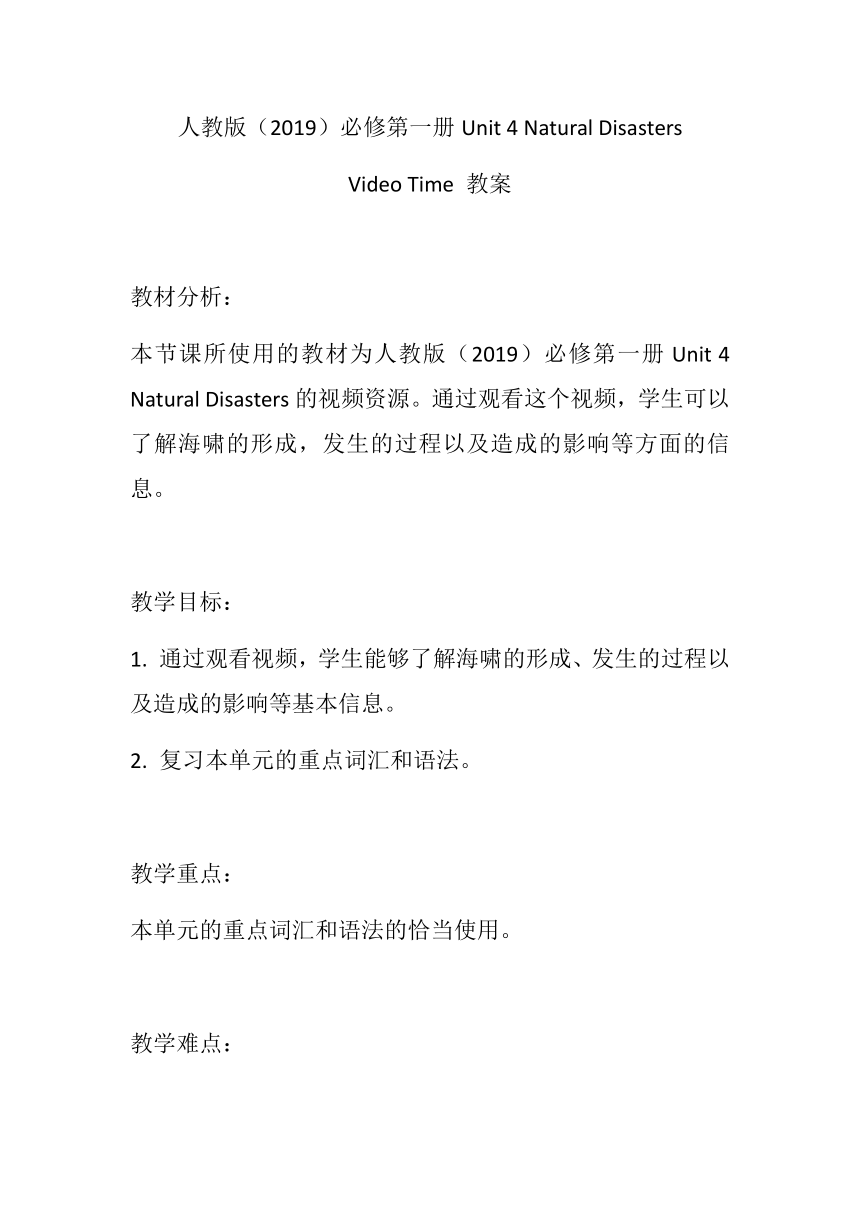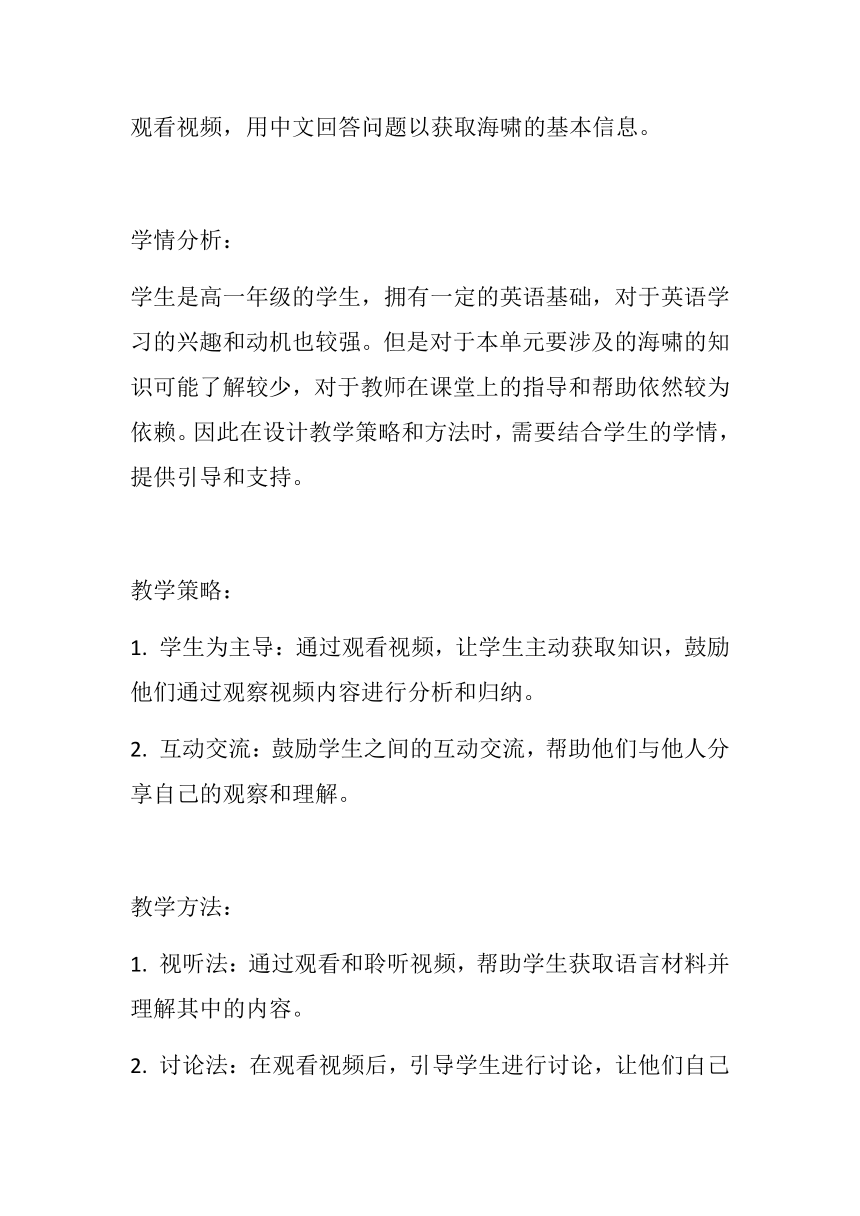人教版(2019)必修第一册Unit 4 Natural Disasters Video Time 教案
文档属性
| 名称 | 人教版(2019)必修第一册Unit 4 Natural Disasters Video Time 教案 |

|
|
| 格式 | docx | ||
| 文件大小 | 19.8KB | ||
| 资源类型 | 教案 | ||
| 版本资源 | 人教版(2019) | ||
| 科目 | 英语 | ||
| 更新时间 | 2023-09-23 10:03:10 | ||
图片预览




文档简介
人教版(2019)必修第一册Unit 4 Natural Disasters
Video Time 教案
教材分析:
本节课所使用的教材为人教版(2019)必修第一册Unit 4 Natural Disasters的视频资源。通过观看这个视频,学生可以了解海啸的形成,发生的过程以及造成的影响等方面的信息。
教学目标:
1. 通过观看视频,学生能够了解海啸的形成、发生的过程以及造成的影响等基本信息。
2. 复习本单元的重点词汇和语法。
教学重点:
本单元的重点词汇和语法的恰当使用。
教学难点:
观看视频,用中文回答问题以获取海啸的基本信息。
学情分析:
学生是高一年级的学生,拥有一定的英语基础,对于英语学习的兴趣和动机也较强。但是对于本单元要涉及的海啸的知识可能了解较少,对于教师在课堂上的指导和帮助依然较为依赖。因此在设计教学策略和方法时,需要结合学生的学情,提供引导和支持。
教学策略:
1. 学生为主导:通过观看视频,让学生主动获取知识,鼓励他们通过观察视频内容进行分析和归纳。
2. 互动交流:鼓励学生之间的互动交流,帮助他们与他人分享自己的观察和理解。
教学方法:
1. 视听法:通过观看和聆听视频,帮助学生获取语言材料并理解其中的内容。
2. 讨论法:在观看视频后,引导学生进行讨论,让他们自己总结海啸的形成、发生的过程以及造成的影响等基本信息。
3. 提问法:通过提问的方式,检查学生对于本单元重点词汇和语法的理解和掌握程度。
教学过程如下:
导入环节(约5分钟):
1. 引入话题:老师可以向学生介绍自然灾害的常见类型,如地震、海啸等,并通过提问激发学生探索与海啸有关的知识的兴趣。
2. 师生互动:老师可以请学生谈谈对海啸的了解,以及对海啸的感受或意见。
教学内容:
1. 视频观看:让学生观看一段关于海啸的视频,学生需要仔细观察视频中的画面,并尝试回答以下问题:
- 海啸是如何形成的?
- 海啸发生的过程是什么?
- 海啸对人类和环境造成了哪些影响?
教学活动:
1. 观看视频:播放与海啸相关的视频段落,让学生经过观看并思考上述问题。
2. 分组讨论:将学生分成小组,让他们在小组内讨论观看到的内容,并尝试回答问题。然后,每个小组可以派代表分享他们的发现和看法。
3. 全班讨论:在小组分享后,进行全班讨论,让每个学生可以分享自己的观点和经验。
结束环节(约5分钟):
1. 复习重点词汇和语法:通过提问和练习,复习本单元的重点词汇和语法,如形容词、副词、被动语态等。
2. 总结课堂内容:对本节课的教学内容进行总结和归纳,确保学生对海啸有更深入的理解,并强调学生应关注自然灾害,并以积极态度准备面对和应对。
教学过程中,老师应注意培养学生的观察能力和思考能力,鼓励学生积极参与讨论和提问,以激发他们的学习兴趣和主动性。同时,要确保教学内容的清晰度和教学方法的多样性,以适应不同学生的学习需求。
Classroom exercises:
1. What is the main topic of the video
A. Earthquakes
B. Forest fires
C. Natural disasters
D. Hurricanes
Answer: C. Natural disasters
Explanation: The video discusses various natural disasters, including tsunamis.
2. What is the purpose of the video
A. To provide information about different natural disasters
B. To discuss the effects of earthquakes
C. To teach students how to evacuate during a tsunami
D. To explain the causes of forest fires
Answer: A. To provide information about different natural disasters
Explanation: The video aims to educate students about different types of natural disasters, including tsunamis.
3. How are tsunamis formed
A. By volcanic eruptions
B. By earthquake-generated disruptions of the ocean floor
C. By heavy rain and flooding
D. By strong winds and storm surges
Answer: B. By earthquake-generated disruptions of the ocean floor
Explanation: The video explains that tsunamis are typically caused by undersea earthquakes that generate large disruptions of the ocean floor.
Teaching reflection:
During the teaching of this lesson, I observed a few areas that could be improved. Firstly, I noticed that some students struggled to fully understand the video due to the language barrier. To improve comprehension, I could consider providing English subtitles or an accompanying transcript for the video. This way, students can read along while watching to enhance their understanding.
Additionally, while the video effectively provided information about tsunamis, it did not specifically address the effects or impacts of tsunamis. To further enhance the students' understanding of the topic, I could incorporate additional resources, such as images or real-life stories, that illustrate the devastating consequences of tsunamis. This would help students develop a deeper appreciation and empathy for those affected by such natural disasters.
Furthermore, I observed that some students struggled to recall and use the key vocabulary and grammar structures from the unit during the discussion and exercises. To address this issue, I could allocate more time for vocabulary and grammar revision activities before diving into the video content. This would help ensure that students have a solid foundation of the necessary language skills to effectively comprehend and discuss the video topic.
In conclusion, while the video served as a valuable resource for providing information about tsunamis, there are areas for improvement in terms of comprehension support and ensuring students can effectively apply the learned vocabulary and grammar. By incorporating these changes, I believe the lesson can be even more engaging and impactful for the students.
Video Time 教案
教材分析:
本节课所使用的教材为人教版(2019)必修第一册Unit 4 Natural Disasters的视频资源。通过观看这个视频,学生可以了解海啸的形成,发生的过程以及造成的影响等方面的信息。
教学目标:
1. 通过观看视频,学生能够了解海啸的形成、发生的过程以及造成的影响等基本信息。
2. 复习本单元的重点词汇和语法。
教学重点:
本单元的重点词汇和语法的恰当使用。
教学难点:
观看视频,用中文回答问题以获取海啸的基本信息。
学情分析:
学生是高一年级的学生,拥有一定的英语基础,对于英语学习的兴趣和动机也较强。但是对于本单元要涉及的海啸的知识可能了解较少,对于教师在课堂上的指导和帮助依然较为依赖。因此在设计教学策略和方法时,需要结合学生的学情,提供引导和支持。
教学策略:
1. 学生为主导:通过观看视频,让学生主动获取知识,鼓励他们通过观察视频内容进行分析和归纳。
2. 互动交流:鼓励学生之间的互动交流,帮助他们与他人分享自己的观察和理解。
教学方法:
1. 视听法:通过观看和聆听视频,帮助学生获取语言材料并理解其中的内容。
2. 讨论法:在观看视频后,引导学生进行讨论,让他们自己总结海啸的形成、发生的过程以及造成的影响等基本信息。
3. 提问法:通过提问的方式,检查学生对于本单元重点词汇和语法的理解和掌握程度。
教学过程如下:
导入环节(约5分钟):
1. 引入话题:老师可以向学生介绍自然灾害的常见类型,如地震、海啸等,并通过提问激发学生探索与海啸有关的知识的兴趣。
2. 师生互动:老师可以请学生谈谈对海啸的了解,以及对海啸的感受或意见。
教学内容:
1. 视频观看:让学生观看一段关于海啸的视频,学生需要仔细观察视频中的画面,并尝试回答以下问题:
- 海啸是如何形成的?
- 海啸发生的过程是什么?
- 海啸对人类和环境造成了哪些影响?
教学活动:
1. 观看视频:播放与海啸相关的视频段落,让学生经过观看并思考上述问题。
2. 分组讨论:将学生分成小组,让他们在小组内讨论观看到的内容,并尝试回答问题。然后,每个小组可以派代表分享他们的发现和看法。
3. 全班讨论:在小组分享后,进行全班讨论,让每个学生可以分享自己的观点和经验。
结束环节(约5分钟):
1. 复习重点词汇和语法:通过提问和练习,复习本单元的重点词汇和语法,如形容词、副词、被动语态等。
2. 总结课堂内容:对本节课的教学内容进行总结和归纳,确保学生对海啸有更深入的理解,并强调学生应关注自然灾害,并以积极态度准备面对和应对。
教学过程中,老师应注意培养学生的观察能力和思考能力,鼓励学生积极参与讨论和提问,以激发他们的学习兴趣和主动性。同时,要确保教学内容的清晰度和教学方法的多样性,以适应不同学生的学习需求。
Classroom exercises:
1. What is the main topic of the video
A. Earthquakes
B. Forest fires
C. Natural disasters
D. Hurricanes
Answer: C. Natural disasters
Explanation: The video discusses various natural disasters, including tsunamis.
2. What is the purpose of the video
A. To provide information about different natural disasters
B. To discuss the effects of earthquakes
C. To teach students how to evacuate during a tsunami
D. To explain the causes of forest fires
Answer: A. To provide information about different natural disasters
Explanation: The video aims to educate students about different types of natural disasters, including tsunamis.
3. How are tsunamis formed
A. By volcanic eruptions
B. By earthquake-generated disruptions of the ocean floor
C. By heavy rain and flooding
D. By strong winds and storm surges
Answer: B. By earthquake-generated disruptions of the ocean floor
Explanation: The video explains that tsunamis are typically caused by undersea earthquakes that generate large disruptions of the ocean floor.
Teaching reflection:
During the teaching of this lesson, I observed a few areas that could be improved. Firstly, I noticed that some students struggled to fully understand the video due to the language barrier. To improve comprehension, I could consider providing English subtitles or an accompanying transcript for the video. This way, students can read along while watching to enhance their understanding.
Additionally, while the video effectively provided information about tsunamis, it did not specifically address the effects or impacts of tsunamis. To further enhance the students' understanding of the topic, I could incorporate additional resources, such as images or real-life stories, that illustrate the devastating consequences of tsunamis. This would help students develop a deeper appreciation and empathy for those affected by such natural disasters.
Furthermore, I observed that some students struggled to recall and use the key vocabulary and grammar structures from the unit during the discussion and exercises. To address this issue, I could allocate more time for vocabulary and grammar revision activities before diving into the video content. This would help ensure that students have a solid foundation of the necessary language skills to effectively comprehend and discuss the video topic.
In conclusion, while the video served as a valuable resource for providing information about tsunamis, there are areas for improvement in terms of comprehension support and ensuring students can effectively apply the learned vocabulary and grammar. By incorporating these changes, I believe the lesson can be even more engaging and impactful for the students.
